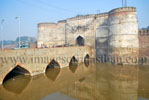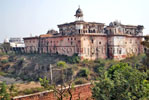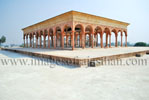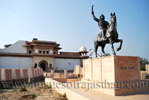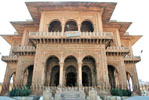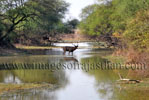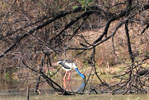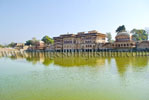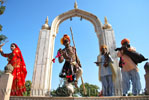|
The city is named after Bharat, the brother of Lord Ram. Although a separate Jat state under the rulership of Badan Singh came into existence for the first time in 1722 AD, the foundation of Bharatpur
city was laid in 1733 AD, when Suraj Mal, an adopted son of Badan Singh captured it from Khemkaran, a rival Jat chief. Suraj Mal constructed the big fort and the earthen wall around the city. The
Bharatpur Fort, with walls of solid packed mud is surrounded by a deep uncrossable moat. The fort is popularly known as "Loha Garh" or Iron Fort. The strength and invincibility of this humble
looking fort of mud wall were tested by the British in the memorable siege of Bharatpur in 1805. Lord Lake's forces, which included field artillery, a siege-train of six 18-pounders and 8 mortars
together with three companies of pioneers and engineers, sieged the Bharatpur Fort. The Fort did not look formidable to the attacking forces. Batteries were opened in January. Four assaults were made,
the first on January 9, the second on January 21, the third on February 20, and fourth on February 21, and all failed miserable. The British lost 3203 men in action with the besieging guns, and
incressant firing. The British had to lift the siege and were eventually obliged to make peace with the ruler of Bharatpur. It was later captured by the British troops in 1826 AD. The Historical masonry
stone fort, having high walls and surrounded by very wide and deep moat; stands in the north western part of the city. The fort has two gates; the gate towards the south is called Chowbhurja and the
other facing the north is called Ashtdhatu gate (eight mettalled gate). A number of buildings and palaces are located inside the fort. One of the palaces known as Kamrakhas with a big durbar hall is a
place for tourist interest. Jawahar Burj is a Victory Tower and was erected in the year 1765 AD, to celebrate the victory over the imperial city of Delhi. Remnants of the old mud wall, the moats
surrounding the fort and the eight bastions that once provided the strength to the fort, are still there. Other buildings of tourist interest in the city include Laxman temple, Gana temple and Moti Mahal.
TOP
PLACES OF INTEREST ARE:
Lohagarh (Iron Fort): Underrated by most visitors to Bharatpur who head for its National Park and Bird Sanctuary, the fort held by the Jat rulers of this state has bastions of sand
that were strong enough to absorb the impact of canonshells that simply embedded themselves within it. Impregnable to most attacks, this 18th century fort was ordered by Maharaja Suraj Mal, the
founder of the dynasty at Bharatpur. Lohagarh is located in the heart of the old city. And its entrance is from a crowded street that leads through the massive entrance gate into what is a living
fort with several modern additions. However, the part of the fort that has been preserved consists of sprawling palace complex since it combines Rajput and Mughal architecture with Jat influences in
building style, a few of eight original towers of which Jawahar Burj and Fateh Burj are of particular interest, and floors laid with tiles.
Jawahar Burj and Fateh Burj: A few of the eight imposing towers still stand erect within the glorious ramparts of the Fort. Especially two of them - Jawahar Burj and Fateh Burj are of special
interest. These were build by Maharaja Suraj Mal to commemorate his victories over the Mughals and British respectively. The coronation ceremony of the Jat rulers of Bharatpur was also held at the Jawahar Burj.
The Palace: This Royal edifice is a fusion of the Mughal and Rajput architectural styles with magnificent apartments and intricately designed floor tiles having interesting patterns. Once
can marvel at the ancient exhibits displayed in the museum in the central part of the palace.
Keoladeo National Park: The natural shallow depressions near the city of Bharatpur when temporarily filled with rain water provided an aquatic habitat and attracted water birds till they
dried up. The credit of converting this area into a world famous wildfowl reserve goes to Prince Bhamji of Morvi State in Gujarat. He was appointed as a Regent of Bharatpur State towards the end of
the nineteenth century. A number of bunds, dykes and embankments were built and provided with sluice gates to regulate the water in the water bodies so created. These were filled up by releasing
water from Ajan Bund, a ten kilometer long flood control weir, built some 250 years ago. Duck shoots were organized in the area every year by the rulers of Bharatpur in honour of British and
Indian dignitaries. First shoot was organized in honour of the Viceroy Lord Curzon and his party on 1st December, 1902. The exploits of all visiting dignitaries since 1902 have been engraved
on stone plaques standing near the Keoladeo temple. Largest number of birds were killed on 12th November, 1938, by Lord Linlithgow, Viceroy & Governor General of India and his party. After
independence of the country this reserve was notified as a bird sanctuary but the former rulers of Bharatpur continued to enjoy the shooting rights over the area till 1972. The area was notified
as National Park in 1981. However, the notification could be made effective only in November 1982.
This complex eco-system of shallow fresh water swamps, dry savanna grass land and woodlands, supports a vast variety and abundance of wildlife. Over 370 species of birds belonging to 56 families have been
identified in the Keoladeo Ghana National Park. Around 130 species of birds nest within the park itself. Every year, the arrival of the monsoon marks the beginning of nesting activity in these
marshes. In the years of normal rainfall, between ten to twenty thousand nests are built, by storks, egrets, herons, ibises, darters, cormorants and spoonbills, in a short span of about one
and half month, on the Acacia trees planted in the marshes. The composition and complexion of nesting colonies change with each passing day. Observing the behaviors of birds during this period
is a fascinating experience. Experts consider it as one of the best heronary of the world. Winter migrants starts arriving in the park form September onwards. Pintail, shoveller, gadwall, wigeon,
poachards and geese arrive in the large numbers.
The non-aquatic eco-system of the park is also rich in wildlife. It also provides a habitat suitable for land birds. Mammals like deers, antelopes, wild boar, cats, jackals and hyena, etc. and reptiles
like the pythons and monitor lizards are common. The park is open to the visitors throughout the year, but it is more rewarding to visit it between August to March. The best way to see the park is, of
course, is a bicycle or a cycle rickshaw. They are available on hire. Rickshaw pullers have been trained by the park management in bird watching and are quite knowledgeable. Boats are also
available on hire. A boat trip early in the morning or late evening is quite rewarding experience.
TOP
MUSEUMS & ART GALLERIES:
Government Museum: Located in the center of the famous Lohagarh Fort, the Bharatpur Museum houses a rich collection of archaeological wealth of the nearby areas as well as from the old
Bharatpur State. The huge palatial building Kachahari Kalan, once the administrative block of the rulers of Bharatpur State, was converted into a museum in 1944 AD later on, Kamra Khas (personal
chamber) building on the first floor was added to the museum. It exhibits sculptures found during the excavation of old villages e.g. Noh, Mallah, Bareh, Bayana etc. ranging from the Kushan
period (1st centaury AD) to 19th Century AD. Weapons used in battles in the medieval period by the Jat rulers, paintings, manuscripts, zoological specimens, local art and craft and carving
on sandal wood and ivory etc. offer a glimpse into the Glory that was once Bharatpur.
The Art Gallery of the museum has specimens of miniature paintings on leaves of the peepal tree, mica and old lithopapers alongwith the paintings of the Maharajas of Bharatpur. On the upper story
one section consists of various types of guns & miniature canons used during 18th century AD called "Chaddre". These miniature canons-two sets of eleven each, were used by Maharaja Sawai
Jawahar Singh in the battle while passing through the Jaipur territory on his return from a pilgrimage to Pushkar.
TOP
EXCURSIONS:
Deeg: Located 34 kms from Bharatpur is the ancient town of Deeg. It finds mention in Skanda Purana as Dirgha or Dirghapura. The place is now known for its famous water palaces, gardens and
fountains. The famous old fortress of Deeg, which contributed substantially in the making of the Jat Principality, is now in shambles. Its formidable cannons now lie abandoned in the forlorn
for. Deeg was the first capital of the newly carved out Jat State, when Badan Singh was proclaimed its ruler in 1722. the royal palace, built by Badan Singh, on the southern side of the garden
is now called as Purana Mahal or the old palace. Deeg, because of its strategic location and proximity to Mathura and Agra was vulnerable to repeated attacks by invaders. In 1730, the Crown
Prince Surajmal is reported to have erected the strong fortress with towering walls, bastions, a deep moat & high ramparts about 20 feed wide, in the southern portion of the town. Although
Surajmal shifted his capital to Bharatpur, his liking for Deeg did not diminish. He built elegant Bhawans clustered around a garden complex, with fountains in the front & enormous water bodies in
the rear. The entire complex of palaces & gardens is a marvel of engineering skill. The elegance of design and perfection of workmanship of these palaces is not seen elsewhere in India. The
palaces form a quadrangle, in the center of which is a garden, an oblong space of 145 meters by 107 meters, laid out with flower beds and fountains. To the east & west are large masonry tanks,
with another garden on the other side of the western tank beyond the buildings, forming the quadrangle.
The building to the north is called the Nand Bhawan. The main building on the west is called Gopal Bhaan and is the largest of all Palaces. On either side of the Gopal Bhawan are two smaller
buildings, called the Sawan and Bhadon Bhawans. These buildings including the Gopal Bhawan command a view of the western tank and gardens beyond it. These three palaces, although single storey in
the front, have in addition two more floors at the bank. One of the storeys of these palaces is either partially or wholly submerged in water throughout the year. On the southern side of
the quadrangle are two palaces facing north. Once of them, Suraj Bhawan, is built entirely of marble and is tastefully ornamented with stones of different colours. The other palace, built of grey
sandstone, is called the Kishan Bhawan. On the roof of this palace is a large water reservoir which feeds the fountains spread all over the garden. The reservoir was filled with water from two
large wells. The engineering skill of this foof to hild such an enormous quantity of water has no parallel anywhere. James Fergusson in his History of Indian and Eastern Architecture says
that the Deeg palaces have been built on a perfectly level plain and laid out with a regularity that would satisfy the most fastidious renaissance architect. The palaces lack the massive
character of the fortified palaces of Rajput States but in grandeur of conception and beauty of details, they surpass them all. These bhawans are built along the four sides of Garden. The
Jat rulers of Deef and Bharatpur were influenced by the grandeur of the Mughal courts of Agra and Delhi. They were keen on making their palace better or at least equal to them. They brought all
item like gates, stone slabs, beams etc. from Mughal areas and used them in the construction or decoration of the Palaces. A fine marble swing was brought here as a war trophy by Raja Surajmal
from the Mughal court of Delhi. Similarly, the black marble throne installed in front of Gopal Bhawan is a trophy brought by Maharaja Jawahar Singh, who in 1764 AD secured it on his victory over Delhi.
Bayana: Bayana is located in a small plan, between two hills ranges running more or less parallel to each other near the left bank of the Gambhiri River, in the district of Bharatpur, 36
kms. from Bharatpur. The ancient name of Bayana was Sripatha or Sriprashtha. It is a curious mixture of Hindu and Mohammedan relics. Ruled by stalwarts like Mohammad Ghori, Sikandar Lodhi and
Humayun, Bayana held a special place in history. According to Abul Gazal 'this town is the burial place of many illustrious men'. It can be adjudged that various important battles where fought here.
Ain-e-Akbari mentions that in former times Bayana was the capital of a province of which Agra was merely a dependant village.
The most visited site in Bayana is the famous Bijaigarh Fort which was built by Jadon Raja Bijai Pal in 1040 AD. The Bijaigarh Fort contains several old temples and a red sandstone pillar bearing an
inscription of Vishnuvardham a feudatory of Samudragupta. The fort was described as one of the most famous forts in India by Babur himself. Besided this there is a monolithic sandstone pillar, a
curious combination of Hindu and Mohammedan style, which bears may inscriptions. One also gets to see an old Usha Temple, which was built during the reign of Raja Laxman Sen, by his wife.
FAIRS & FESTIVALS:
Brij Festival: The Brij Festival takes place a few days before Holi, the festival of colours. Held in honour of Lord Krishna, this festival is marked by verve and zest. Villagers, in gay, multihued
attire, can be seen singing and performing the Raslila dance - the immortal love-story of Radha and Krishna. All of Bharatpur comes alive to the sound of folk melodies on this festival held on the eve
of Holi. Men and Women, young and old, rich and poor - all are touched by the spirit of this festival. Boisterous revelers spare no one during this festival and delight in splashing colour on everyone around. |







